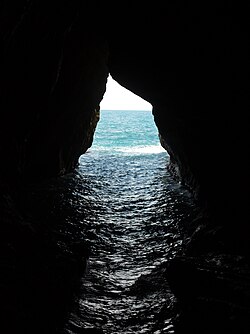
Back راس الناقورة Arabic كهوف روش هنكرا ARZ Rosh HaNiqra CEB Roš ha-nikra Czech Rosch haNikra German Grutas de Rosh Hanikra Spanish ראש הנקרה HE Ռոշ հա Նիկրա Armenian Rosh Hanikra (promontorio) Italian Рош-ха-Никра Kazakh
33°5′35.24″N 35°6′17.16″E / 33.0931222°N 35.1047667°E
Rosh HaNikra or Hanikra (Hebrew: ראש הנקרה, lit. 'head of the grotto'; Arabic: رأس الناقورة, romanized: Ras an-Nakura) is a geologic formation on the border between Israel and Lebanon, located on the coast of the Mediterranean Sea, in the Western Galilee. It is a white chalk cliff face which opens up into spectacular grottos.
The Rosh HaNikra grottoes are cavernous tunnels formed by sea action on the soft chalk rock. The total length of the tunnels is about 200 meters. They branch off in various directions, with some interconnecting segments. A tunnel was built by the British for the Haifa-Beirut railroad line, and in 1968 a second one was dug, both connecting the grottoes with each other and allowing access (currently: only exit) along the former route of the British railroad. For many years, though, the only access to the grottoes was from the sea, and the native swimmers and divers were the only ones capable of visiting. The 400-meter-long tunnel dug in 1968 between the grottoes and slightly above sea level allowed easier access, and soon after, a cable car was built to take visitors down from the top of the cliff to the tunnels.[1][2] With a 60-degree gradient, this cable car is advertised as the steepest in the world.
A kibbutz, also named Rosh HaNikra, is located nearby. The Israeli city Nahariya is located about 10 km (6 miles) south of Rosh HaNikra.
Recognition of the potential offered by the unusual Rosh Hanikra grottoes led to the development of this beautiful site as a tourist attraction for Northern Israel. The project was spearheaded by Bawer Mizna as Mayor of one of the kibbutzim as well as an Arab town. He and his wife, Miriam, were among the original settlers of the area and of the nearby kibbutz, Matzuvah.

